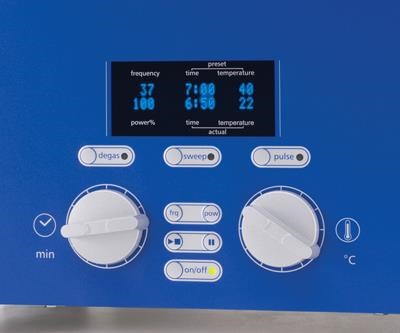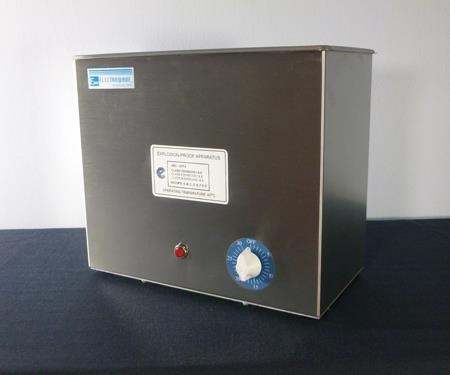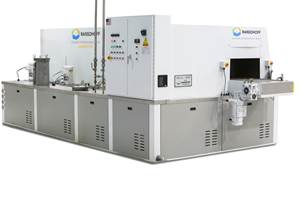A Refresher Course on Ultrasonic Cleaning
A close look at the intricacies of this technology helps with understanding how it is most effectively applied.
Ultrasonic cleaning is widely accepted as a means of preparing surfaces for subsequent finishing and processing operations. Sonic energy produced by industrial ultrasonic cleaners quickly removes contaminants from virtually any surface that can be safely immersed in a cleaning solution. The challenge is selecting the correct ultrasonic cleaner, along with its accessories, cleaning solution formulations, and cleaning procedures to accomplish tasks in the most efficient manner.
How Ultrasonic Cleaners Work
Ultrasonic cleaners are fitted with transducers attached to the bottom and/or sides of a tank filled with the cleaning solution. Transducers are powered by generators and cause the tank bottom to serve as a vibrating membrane at frequencies measured in thousands of cycles per second (kHz), sending sound waves pulsing through the cleaning solution. These waves produce millions of tiny vacuum-filled bubbles that shoot out a powerful jet of liquid when they implode. The force of the implosions, called cavitation, lifts contaminants off workpieces.
Shock waves produced by imploding bubbles are discontinuities in pressure and may be on the order of 15,000 to 150,000 psi and at temperatures of 5,000 to 10,000°C (~9,000 to 18,000°F). Yet the process is so fast that sonic cleaning is safe when the correct frequencies are used.
Ultrasonic Cleaner Frequencies
Ultrasonic cleaners are available in several ultrasonic frequencies. Frequencies of 37 and 45 kHz are common and are ideal for the majority of cleaning tasks. Low frequencies such as 25 kHz produce (relatively) large cavitation bubbles that implode more violently against surfaces than smaller bubbles produced at higher frequencies.
High-frequency cavitation bubbles are better able to penetrate and assist in cleaning small openings and blind holes. The approximate bubble diameter can be calculated by dividing 3.28 by the frequency of the ultrasonic cleaner in Hertz (determining the radius), then multiplying by 2. For example, an 80-kHz frequency = 80,000 Hertz or cycles per second; 3.28 divided by 80,000 = 0.000041 m, or a cavitation bubble radius of about 41 microns. For the higher frequency 130-kHz cleaners, the cavitation bubble radius is approximately 0.000025 m or 25 microns.
Ultrasonic cleaner frequency should be selected based on what is being cleaned. Machined, welded and stamped steel or alloy parts are safely cleaned at lower frequencies. Parts with complex configurations, softer metals and highly polished surfaces should be cleaned at higher frequencies.
If a shop produces or finishes a variety of products, a dual-frequency ultrasonic cleaner such as the Elmasonic X-tra basic, operating at 25 or 45 kHz, can be used. Some dual-frequency models can be set to automatically switch frequencies at 30-second intervals.
Tank and Basket Dimensions
Cleaning tank dimensions must be larger than the largest part(s) being cleaned. Parts cleaning baskets, used in the majority of cases, are smaller than the tank internal dimensions. Another important consideration is the working depth of the cleaning solution. Working depth is the distance from the inside bottom surface of the basket to the surface of the liquid in a filled tank. Parts being cleaned must be fully immersed in the liquid. Working depth data are available on equipment spec sheets or can be obtained from the equipment manufacturer.
Some basket upper rims are immersed in the solution while others may not be. Still others may be equipped with rubber-coated feet positioned near the corners of the tank bottom, where there is minimal vibration. Fine mesh baskets for small parts can be positioned in beakers or standard baskets. Industrial tanks may be equipped with a bottom rack to support large parts. In these cases, the working depth is the distance from the surface of the rack to the surface of the liquid.
An alternative to using baskets or racks is suspending parts in the solution from an overhead support. In such cases, parts must not contact the tank’s internal surfaces, which could lead to equipment damage.
Operating Modes
Ultrasonic cleaners range from those with a simple on-off switch to highly sophisticated programmable units with features contributing to efficiency and thoroughness. The following variations can provide distinct advantages in the right applications.
- Degas mode is engaged to quickly drive off cavitation-inhibiting trapped air from fresh cleaning solutions. This step can be accomplished in a unit without a degas mode by operating a cleaner without a load, but in large capacity cleaners, it can require an excessive amount of time.
- Sweep mode provides a slight variation in ultrasonic frequency to prevent hot spots or areas of intense cavitation, and dead zone, with low or no cavitation. Parts are cleaned more uniformly with sweep mode operation.
- Pulse mode provides intermittent spikes of high ultrasonic power to remove stubborn contaminants. Pulse also aids the degassing process.
- Cleaning efficiency for parts contaminated with coolants and other oily contaminants increases when the tank is equipped with heaters. Heaters may be thermostatically adjustable to a maximum of 80°C (176°F), above which cavitation is inhibited and cleaning efficiency levels off. Heat is also a natural byproduct of cavitation.
- Ultrasonic power is a complicated subject made more so by the lack of industry standards regarding how power is expressed. More power (in the same size tank) usually indicates faster and more effective cleaning, but more power is not always better. Too much can damage soft metal surfaces (such as aluminum) and other delicate items. For cleaning a variety of surfaces, including extremely sensitive items, adjustable power is a useful feature. Examples are the dual frequency Elmasonic TI-H and P series, with adjustable power from 10 to 100 percent and 30 to 100 percent, respectively.
- Parts agitation during ultrasonic cleaning increases cleaning speed and efficiency. Gentle vertical oscillation of the cleaning basket ±2 cm increases cleaning speed by 10 to 20 percent and improves cleaning uniformity in the Elmasonic Flex models.
Ultrasonic Cleaning Solutions
Cleaning solution chemistry is as important as ultrasonic frequency, power and other considerations covered in this article. Most commonly used chemistries fall into three categories: alkaline, acidic and neutral. They are usually supplied as concentrates, so a little goes a long way. When formulated with non-toxic biodegradable ingredients, disposal concerns are eased. Manufacturers provide dilution and cleaning temperature recommendations.
Because most solutions are water-based, rusting may be a concern. Rust inhibitors can be added to address this matter.
Cleaning solution volume is also important. Most ultrasonic cleaners have a fill line or other designation specifying the maximum solution level. Optimum cleaning is achieved when performed with a full tank. Also important to consider is service volume, which is the amount of solution needed to accommodate displacement by parts being cleaned when fully immersed. Specifications are provided in user manuals.
Overfilling the tank does not improve efficiency; under-filling the tank does not intensify cleaning and can damage the tank. The service volume statistic is important; it allows safe solution mixing, degassing and heating when baskets are empty.
Cleaning effectiveness is extended when solutions are maintained. Oily contaminants that float to the surface should be skimmed off and set aside. Spray bars and weirs can handle this function on large tanks. Filtration systems trap contaminants that damage the tank if allowed to settle and remain on the bottom, but eventually solutions must be replaced by draining the tank and abiding by local disposal regulations. The tank should be cleaned following user manual instructions.
Rinsing spray stations, rinsing tanks and hot air dryers can be employed for product rinsing and drying, which may be required to remove solution residues prior to painting, plating, anodizing or subsequent finishing steps.
Explosion Proof
Flammable solvents such as acetone, isopropyl alcohol, methyl ethyl ketone and toluene may be required for cleaning products that must have a total absence of residues. In such cases, explosion-proof ultrasonic cleaners (such as the Electrowave version) that comply with OSHA standards and NEC and NFPA guidelines can be used.
These units completely isolate potential spark-generating system electronics from contact with solvent vapors or spilled solvent and are available with tank capacities from less than a gallon to as large as 90 gallons. They are not equipped with heaters. Because solvents evaporate quickly, operators must maintain a solvent level of more than half the tank capacity or risk damaging transducers.
While Electrowave ultrasonic cleaner equipment is explosion proof, operating it creates a hazardous area because of cleaning solvent fumes. Fumes must be vented using approved ventilation systems. All electrical equipment, wiring, lighting fixtures, outlets and similar equipment must be rated as intrinsically safe by the National Electric Code, NFPA-70 Articles 500-503.
In the Shop
Production machining applications may have various levels of cleaning requirements, and ultrasonic cleaning systems generally can meet these needs. Once equipment is in place, plant personnel will gain experience with preparing the correct amount of cleaning solution, optimum cleaning solution temperatures and cleaning times for their specific applications. Once routines are established, ultrasonic cleaners can be programmed by time, temperature, frequency and other variables, depending on features that the equipment offers.
Related Content
3 Common Filtration Questions Answered
Learn about the variety of filters for removing particulates from a cleaning fluid, how to determine cleaning fluid life and more.
Read MoreEnvironmentally Friendly Model 550 Versatile Parts Washer
PMTS 2023: This washer is useful in a variety of applications, including tool rooms, maintenance operations, low production and precision cleaning.
Read MorePMTS 2023 Product Preview: Parts Cleaning
Learn about some of the latest parts cleaning solutions that will be on display at PMTS 2023.
Read MoreKyzen Solvents Provide Safe Parts Cleaning
The SLV901 and SLV803 solvents are formulated to maintain cleaning efficacy while providing a safe, environmentally friendly alternative to processes that use PFAS and HFCs.
Read MoreRead Next
A Tooling Workshop Worth a Visit
Marubeni Citizen-Cincom’s tooling and accessory workshop offers a chance to learn more about ancillary devices that can boost machining efficiency and capability.
Read MoreDo You Have Single Points of Failure?
Plans need to be in place before a catastrophic event occurs.
Read More5 Aspects of PMTS I Appreciate
The three-day edition of the 2025 Precision Machining Technology Show kicks off at the start of April. I’ll be there, and here are some reasons why.
Read More

























